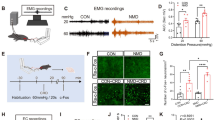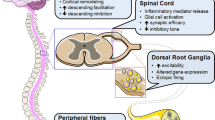Abstract
At the spinal level, μ-opioids exert their actions on nociceptive primary afferent neurons both pre- and postsynaptically. In the present study, we used an in vitro isolated neonatal rat (11–15 days old) spinal cord preparation to examine the effects of morphine and the endogenous μ-opioid ligands endomorphin-1 (EM-1) and endomorphin-2 (EM-2) on the polysynaptic reflex (PSR) of dorsal root-ventral root (DR-VR) reflex. The actions of μ-opioids on spinal nociception were investigated by quantification of the firing frequency and the mean amplitude of the PSR evoked by stimuli with 20×threshold intensity. EM-1 decreased the mean amplitude of PSR, whereas EM-2 and morphine decreased the firing frequency. The pattern of the effects elicited by morphine was the same as that for EM-2, except at high concentration. Naloxonazine, a selective μ1 opioid receptor antagonist, had no significant effect on PSR by itself, but blocked the inhibition of PSR firing frequency or amplitude induced by EM-1, -2 and morphine. This may suggest that EM-1, EM-2 and morphine modulate spinal nociception differently and act mainly at the μ1-opioid receptors. Although they all act via μ1-opioid receptors, their different effects on the PSR may suggest the existence of different subtypes of the μ1-opioid receptor. The present data is also consistent with a further hypothesis, namely, that morphine and EM-2 activate a subtype of μ1-opioid receptor presynaptically, while EM-1 acts mainly through another subtype postsynaptically. However, since other reports indicate that EM-2, but not EM-1, could stimulate the release of enkephalins or dynorphin, presynaptic δ and κ receptors may be also involved indirectly in the different regulation by μ-opioids at the spinal level.









Similar content being viewed by others
References
Basbaum AI, Jessell TM (2000) The perception of pain. In: Jessell TM, Kandel ER, Schwartz JH (eds) Principles of neural science, 4th edn. McGraw-Hill, New York, pp 472–491
Chen JC, Tao PL, Li JY, Wong CH, Huang EY (2003) Endomorphin-1 and -2 induce naloxone-precipitated withdrawal syndromes in rats. Peptides 24:477–481
Crain SM, Shen KF (1990) Opioids can evoke direct receptor-mediated excitatory effects on sensory neurons. Trends Pharmacol Sci 11:77–81
Csullog E, Joo G, Toth G, Dobos I, Benedek G, Horvath G (2001) Antinociceptive effect of continuous intrathecal administration of endomorphin-1. Pain 94:31–38
Deshpande SB (1993) Significance of monosynaptic and polysynaptic reflexes in neonatal rat spinal cord in vitro. Indian J Exp Biol 31:850–854
Hao S, Takahata O, Iwasaki H (2000) Intrathecal endomorphin-1 produces antinociceptive activities modulated by alpha 2-adrenoceptors in the rat tail flick, tail pressure and formalin tests. Life Sci 66:PL195–PL204
Higashida H, Hoshi N, Knijnik R, Zadina JE, Kastin AJ (1998) Endomorphins inhibit high-threshold Ca2+ channel currents in rodent NG108-15 cells overexpressing μ-opioid receptors. J Physiol (Lond) 507:71–75
Horvath G, Szikszay M, Tomboly C, Benedek G (1999) Antinociceptive effects of intrathecal endomorphin-1 and -2 in rats. Life Sci 65:2635–2641
Huang EY, Bagust J, Sharma RP, Walker RJ (1998) The effect of FMRF-amide-like peptides on electrical activity in isolated mammalian spinal cord. Neurosci Res 30:295–301
Huang EY, Chen CM, Tao PL (2004) Supraspinal anti-allodynic and rewarding effects of endomorphins in rats. Peptides 25:577–583
Kerkut GA, Bagust J (1995) The isolated mammalian spinal cord. Prog Neurobiol 46:1–48
Martin-Schild S, Zadina JE, Gerall AA, Vigh S, Kastin AJ (1997) Localization of endomorphin-2-like immunoreactivity in the rat medulla and spinal cord. Peptides 18:1641–1649
Martin-Schild S, Gerall AA, Kastin AJ, Zadina JE (1998) Endomorphin-2 is an endogenous opioid in primary sensory afferent fibers. Peptides 19:1783–1789
Martin-Schild S, Gerall AA, Kastin AJ, Zadina JE (1999) Differential distribution of endomorphin 1- and endomorphin 2-like immunoreactivities in the CNS of the rodent. J Comp Neurol 405:450–471
Maruoka Y, Ohno Y, Tanaka H, Yasuda H, Otani K, Tamamura C, Nakamura M (1998) Effects of the novel tricyclic quinoxalinedione derivatives, SM-18400 and its analogs, on N-methyl-d-aspartate (NMDA) receptor-mediated synaptic transmission in the isolated neonatal rat spinal cord in vitro. Jpn J Pharmacol 76:265–270
North RA (1991) Opioid receptors and ion channels. In: Almeida OFX, Shippenberg TS (eds) Neurobiology of opioids. Springer, Berlin Heidelberg New York, pp 141–150
Ohsawa M, Mizoguchi H, Narita M, Nagase H, Kampine JP, Tseng LF (2001) Differential antinociception induced by spinally administered endomorphin-1 and endomorphin-2 in the mouse. J. Pharmacol Exp Ther 298:592–597
Okada Y, Tsuda Y, Bryant SD, Lazarus LH (2002) Endomorphins and related opioid peptides. Vitam Horm 65:257–279
Otsuka M, Konishi S (1974) Electrophysiology of mammalian spinal cord in vitro. Nature 252:733–734
Pierce TL, Grahek MD, Wessendorf MW (1998) Immunoreactivity for endomorphin-2 occurs in primary afferents in rats and monkey. Neuroreport 9:385–389
Sakurada S, Zadina JE, Kastin AJ, Katsuyama S, Fujimura T, Murayama K, Yuki M, Ueda H, Sakurada T (1999) Differential involvement of μ-opioid receptor subtypes in endomorphin-1 and -2-induced antinociception. Eur J Pharmacol 372:25–30
Sakurada S, Hayashi T, Yuhki M, Fujimura T, Murayama K, Yonezawa A, Sakurada C, Takeshita M, Zadina JE, Kastin AJ, Sakurada T (2000) Differential antagonism of endomorphin-1 and endomorphin-2 spinal antinociception by naloxonazine and 3-methoxynaltrexone. Brain Res 881:1–8
Sakurada S, Hayashi T, Yuhki M, Orito T, Zadina JE, Kastin AJ, Fujimura T, Murayama K, Sakurada C, Sakurada T, Narita M, Suzuki T, Tan-no K, Tseng LF (2001) Differential antinociceptive effects induced by intrathecally administered endomorphin-1 and endomorphin-2 in the mouse. Eur J Pharmacol 427:203–210
Sanchez-Blazquez P, Rodriguez-Diaz M, DeAntonio I, Garzon J (2003) Endomorphin-1 and endomorphin-2 show differences in their activation of μ opioid receptor-regulated G proteins in supraspinal antinociception in mice. J Pharmacol Exp Ther 291:12–18
Schumacher MA, Basbaum AI, Way WL (2004) Opioid analgesics and antagonists. In: Katzung BG (ed) Basic and clinical pharmacology, 9th edn. McGraw-Hill, New York, pp 497–516
Soignier RD, Vaccarino AL, Brennan AM, Kastin AJ, Zadina JE (2000) Analgesic effects of endomorphin-1 and endomorphin-2 in the formalin test in mice. Life Sci 67:907–912
Stone LS, Fairbanks CA, Laughlin TM, Nguyen HO, Bushy TM, Wessendorf MW, Wilcox GL (1997) Spinal analgesic actions of the new endogenous opioid peptides endomorphin-1 and -2. Neuroreport 8:3131–3135
Wu HE, Hung KC, Mizoguchi H, Fujimoto JM, Tseng LF (2001) Acute antinociceptive tolerance and asymmetric cross-tolerance between endomorphin-1 and endomorphin-2 given intracerebroventricularly in the mouse. J Pharmacol Exp Ther 299:1120–1125
Zadina JE, Hackler L, Ge LJ, Kastin AJ (1997) A potent and selective endogenous agonist for the μ-opiate receptor. Nature 386:499–502
Zhang L, Morgan E, Bagust J, Williams RG (1998) c-fos expression in isolated rat spinal cord. J Neurosci Methods 79:105–113
Acknowledgements
This study was supported by the grants from the National Health Research Institutes (NHRI-EX93-8909BP) and the National Science Council (NSC 92-2320-B-016-016), Taipei, Taiwan, R.O.C.
Author information
Authors and Affiliations
Corresponding author
Rights and permissions
About this article
Cite this article
Tao, PL., Lai, YS., Chow, LH. et al. Effects of morphine and endomorphins on the polysynaptic reflex in the isolated rat spinal cord. Naunyn-Schmiedeberg's Arch Pharmacol 371, 72–80 (2005). https://doi.org/10.1007/s00210-004-1004-8
Received:
Accepted:
Published:
Issue Date:
DOI: https://doi.org/10.1007/s00210-004-1004-8




